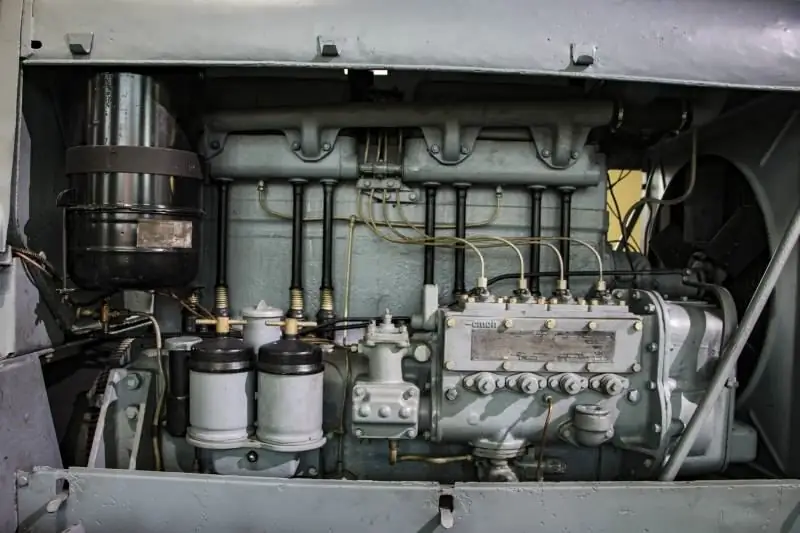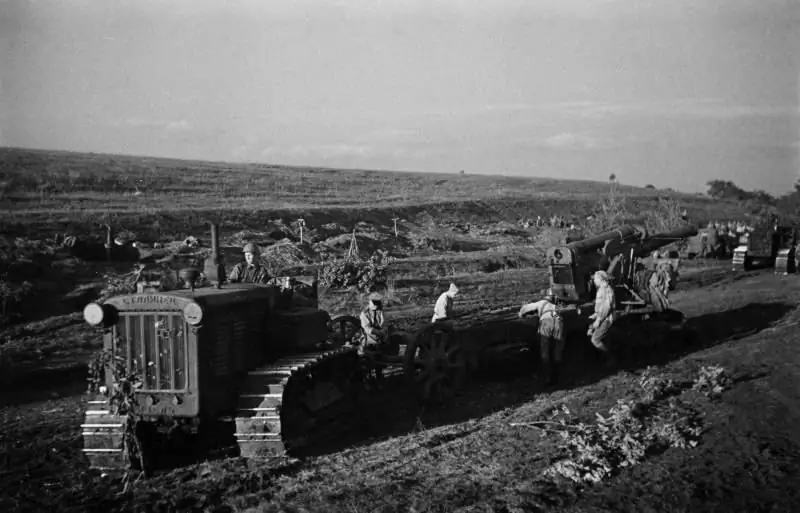- Author Matthew Elmers [email protected].
- Public 2023-12-16 21:49.
- Last modified 2025-01-24 09:17.

Someone might say that a tractor is not a weapon. But this is how to approach this issue. Of course, in normal times, the tractor is a toiler of the fields, but if hard times of war come, the tractor becomes the first assistant of the gunners. So if not a weapon in the literal sense, then without a tractor it is difficult to imagine some aspects of army life.
"Stalinets-65", or S-65, was produced at the Chelyabinsk Tractor Plant from 1937 to 1941. The numbers in the name indicate the horsepower of the M-17 diesel engine. It was the first Soviet diesel tractor.
Specifications:
The number of seats in the cockpit is 2.
Weight, kg - 11 200.
Trailer weight, t - up to 10.
Dimensions, m:
length - 4, 09;
width - 2, 395;
height - 2, 77;
clearance - 0, 405.
Diesel engine, 65 h.p. (47.8 kW).
Gearbox - 3 forward and 1 back.
Max. speed, km / h - 7, 0 forward and 2, 5 back.
Fuel capacity, l - 300.
Naphtha / diesel top.
A bit of history.
In January 1935, S. Ordzhonikidze, speaking at the VII All-Union Congress of Soviets, points out the need to transfer ChTZ tractors to diesel engines as soon as possible. The advantages of a diesel engine over naphtha engines were obvious - cheap fuel, higher efficiency, and a number of others. It was decided to start preparing the plant for reconstruction, and the design of the diesel engine was started back in February.
On July 15, a diesel engine M-17 with a power of 47.8 kW was assembled, on August 1 it was tested, and on August 14 a prototype of the C-65 diesel tractor made a 15-kilometer run.
The new M-17 engine, which was a "descendant" of the M-13 and M-75 engines, in addition to diesel fuel, could also run on a mixture of autol with kerosene, and was started from a starting 20-horsepower gasoline engine with an electric starter. Started up, according to sources, in a 30-degree frost quite calmly and without dancing with tambourines. The "launcher" could also be started manually, with the help of a "crooked" starter. Simultaneously with the cranking of the diesel engine, its cooling system and intake system warmed up.
The name of the new S-65 tractor was not in vain. Compared to the predecessor of the S-60, there were many changes.
Changes were made: the gearbox - since the new engine provided a higher number of revolutions per minute (850 versus 650), the gear ratio was increased, the tracks - for better weight distribution, the radiator, which became slightly wider. The fuel tank was now located behind the engine, which was covered with a hood on top.



The pads at the bottom are for a reason. The machine is working, so it always leaks from somewhere. Age…
In March 1937, the last C-60s were produced by the plant; the conveyor was inactive for more than two months. After re-equipment on June 20, the first C-65 diesel tractor came off it.
In February 1938, the first batch of 60 S-65s was exported.
In general, the world recognition for the S-65 came even before it was put on stream. In May 1937, the international exhibition "Art and Technology of Modern Life" opened in Paris. Among the exhibits of the Soviet section was a sample of the S-65. He was awarded the "Grand Prix" of the exhibition.
The advantages of a diesel engine are obvious - it runs on cheaper fuel, has a higher efficiency and a number of other advantages. Plowing 1 hectare with such a machine is much cheaper than a tractor with an engine running on naphtha.



The dieselization of the country's tractor fleet began with the S-65 tractor. The success that came to Soviet designers in 1937 allowed our country, twenty years later, to be the first in the world to convert the entire tractor industry to diesel.
"Stalinist" inside.
The cabin, I must say, is spacious. The driver's seat can be called luxurious, especially when compared to the cars of the time.

The sofa, as it is, is a sofa.


The amusing wooden structure of the windows made it possible to ventilate the cab well, which was not superfluous at the prohibitive speed of the tractor of 7 km / h.

Not to say that there are many devices, but everything is on the topic.


General layout of the cockpit. There are a lot of levers, but not for those who know when to pull for what.

The view from the cockpit can be said to be significant. There, in front, there is a tank. T-26. "Stalinist" in size you can see how.
Over the years of production, more than 37,000 Stalinets tractors have been manufactured.
With the outbreak of World War II and heavy losses in the first period, most of the tractors were withdrawn from agriculture. In the Red Army, tractors were used to tow high-power guns, in particular, in the photographs that have come down to us "Stalinists" with 152-mm ML-20 guns.








A large number of tractors went to the Germans as trophies, who also used them to tow their medium and large caliber guns. And not only weapons.

There was also a modification of the "Stalinists" - a gas generator. In May 1936, an experimental design bureau for gas-generating tractors, headed by V. Mamin, was organized in Chelyabinsk. In 1936, the bureau introduced into production the Dekalenkov gas generator - D-8, adapting it to the S-60 tractor, a total of 264 units were produced. When the S-60 was taken out of production, a more advanced NATI G-25 generator was installed on the S-65, which, in comparison with the D-8, produced a better purified and cooled gas. Due to the improved gas quality, the engine developed more power. In addition, the NATI generator could work on wetter chocks. In total, 7355 SG-65 gas-generating tractors came out of the gates of ChTZ.

What can I say in conclusion? Mighty tractor. And if you still remember when it was developed and produced … Just 20 years after the creation of the USSR, there was already a tractor with its own, I emphasize, a diesel engine. Yes, we were not the first in the matter of equipping with diesel engines, the Germans were ahead of us. But the fact that the S-65 plowed the whole war only says that the diesel was very, very good. As well as the tractor that has been dragging 122-mm and 152-mm howitzers for all 4 years.
Good car.
The exhibit for photography was provided by the Museum of Russian Military History (Padikovo, Moscow Region).






